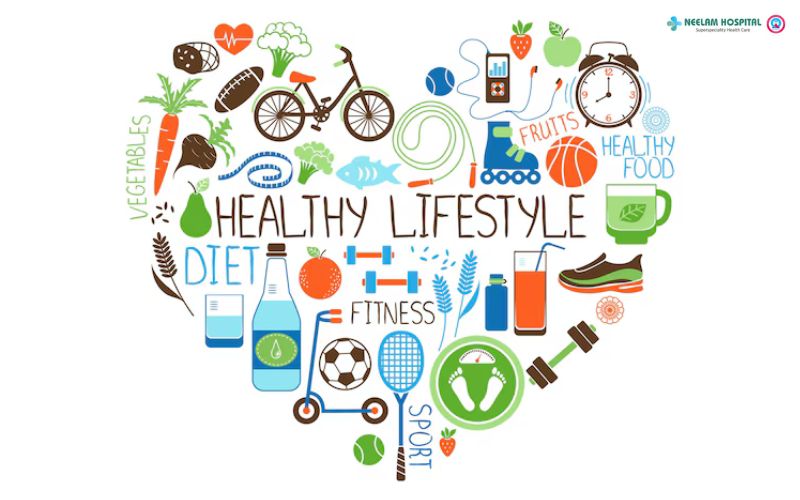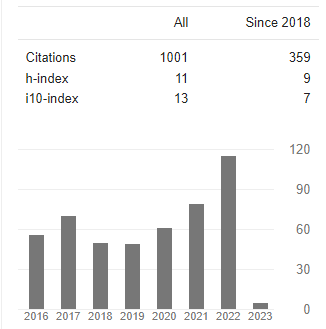Evaluation Of Healthy Lifestyle And Wellbeing Among Employees In Physical Education Departments Across Various Schools
Abstract
This study assesses the health and well-being of personnel in Physical Education (PE) departments in different schools using the "Lifestyle Assessment Inventory" developed by Anspaugh, Hamrich, and Rosato. A total of 100 employees from the PE department took part in the survey, offering a thorough examination of their health behaviours and measures of wellbeing. The Lifestyle Assessment Inventory evaluates many aspects of lifestyle, such as physical activity, nutrition, stress management, and social support. Analytical techniques such as descriptive statistics and correlation, were employed to examine and interpret the data. The results indicated that 85% of the participants complied with the specified guidelines for physical activity, whilst 60% followed balanced nutrition practices. Strong positive associations were seen between physical activity and overall wellbeing (r = 0.45, p < 0.01), nutrition and wellbeing (r = 0.38, p < 0.01), social support and wellbeing (r = 0.42, p < 0.01), and stress management and wellbeing (r = 0.50, p < 0.01). The study proposes that focused interventions designed to enhance these lifestyle behaviours could significantly influence the health and welfare of physical education professionals, thereby benefiting the wider educational community. Subsequent studies should prioritise the creation and assessment of customised programmes designed to meet the distinct requirements of physical education department personnel, with the aim of further improving their overall health and welfare.
Downloads
References
Alameri AA, Ghanni MU, Ali A, Singh M, Al-Gazally ME, Almulla AF, Alexis Ramírez-Coronel A, Mustafa YF, Gupta R, Obaid RF, Gabr GA, Farhood B. The Effects of Curcumin on Astrocytes in Common Neurodegenerative Conditions. Mini Rev Med Chem. 2023;23(22):2117-2129. doi: 10.2174/1389557523666230502143131. PMID: 37132107. https://pubmed.ncbi.nlm.nih.gov/37132107/
Anspaugh, D. J., Hamrick, M. H., & Rosato, F. D. (2004). Wellness: Concepts and applications (6th ed.). McGraw-Hill.
American College of Sports Medicine (ACSM). (2018). ACSM's guidelines for exercise testing and prescription (10th ed.). Wolters Kluwer Health.
Berkman, L. F., & Kawachi, I. (Eds.). (2000). Social epidemiology. Oxford University Press.
Biddle, S. J. H., & Mutrie, N. (2008). Psychology of physical activity: Determinants, well-being, and interventions (2nd ed.). Routledge.
Blair, S. N., Cheng, Y., & Holder, J. S. (2001). Is physical activity or physical fitness more important in defining health benefits? Medicine & Science in Sports & Exercise, 33(6), S379-S399. https://doi.org/10.1097/00005768-200106001-00007
Centers for Disease Control and Prevention (CDC). (2020). Physical activity guidelines for Americans (2nd ed.). U.S. Department of Health and Human Services. https://health.gov/paguidelines/second-edition/
Cohen, S., Underwood, L. G., & Gottlieb, B. H. (Eds.). (2000). Social support measurement and intervention: A guide for health and social scientists. Oxford University Press.
Danna, K., & Griffin, R. W. (1999). Health and well-being in the workplace: A review and synthesis of the literature. Journal of Management, 25(3), 357-384. https://doi.org/10.1177/014920639902500305
Dishman, R. K., Heath, G. W., & Lee, I. M. (2013). Physical activity epidemiology (2nd ed.). Human Kinetics.
Kaplan, R. M., & Simon, H. S. (1990). Well-being in the workplace: A multidimensional approach. Journal of Occupational Health Psychology, 1(2), 17-22. https://doi.org/10.1037/1076-8998.1.2.17
Leka, S., Griffiths, A., & Cox, T. (2004). Work organization and stress. World Health Organization.
Mandeep Singh Nathial, Analysis of set shot in basketball in relation with time to perform the course and displacement of center of gravity, American Journal of Sports Science, Vol.2 Issue.5 pp: 122-126 (2014). Retrieved from https://www.sciencepublishinggroup.com/journal/paperinfo.aspx?journalid=155&doi=10.11648/j.ajss.20140205.13
Maslach, C., & Leiter, M. P. (2016). Understanding the burnout experience: Recent research and its implications for psychiatry. World Psychiatry, 15(2), 103-111. https://doi.org/10.1002/wps.20311
Penedo, F. J., & Dahn, J. R. (2005). Exercise and well-being: A review of mental and physical health benefits associated with physical activity. Current Opinion in Psychiatry, 18(2), 189-193. https://doi.org/10.1097/00001504-200503000-00013
Sallis, J. F., & Owen, N. (2015). Ecological models of health behavior. In K. Glanz, B. K. Rimer, & K. Viswanath (Eds.), Health behavior: Theory, research, and practice (5th ed., pp. 43-64). Jossey-Bass.
Singh, M., Kadhim, M.M., Turki Jalil, A. et al. A systematic review of the protective effects of silymarin/silibinin against doxorubicin-induced cardiotoxicity. Cancer Cell Int 23, 88 (2023). https://doi.org/10.1186/s12935-023-02936-4 https://cancerci.biomedcentral.com/articles/10.1186/s12935-023-02936-4
Singh, M., Kour, R., & Kour, A.,. A collaborative diversified investigation of respective responses of sports person coaches and organizations on criminalization of doping.International Journal of Health Sciences,6(S3), 11295–11310. https://doi.org/10.53730/ijhs.v6nS3.8641
Singh, A., & Singh , D. M. (2013). PROMOTION OF RESEARCH CULTURE –ENHANCING QUALITY IN HIGHER EDUCATION. International Journal of Behavioral Social and Movement Sciences, 2(2), 202–208. Retrieved from https://ijobsms.org/index.php/ijobsms/article/view/152
SINGH, M., & SINGH SIDHU, A. (2016). A COMPARATIVE STUDY OF BODY COMPOSITION AND RELATIVE HEALTH STATUS AMONG RESIDENT AND NON-RESIDENT STUDENTS IN DIFFERENT SCHOOLS OF J&K. International Journal of Behavioral Social and Movement Sciences, 5(3), 08–13. Retrieved from https://ijobsms.org/index.php/ijobsms/article/view/320
Warburton, D. E., Nicol, C. W., & Bredin, S. S. (2006). Health benefits of physical activity: The evidence. Canadian Medical Association Journal, 174(6), 801-809. https://doi.org/10.1503/cmaj.051351

Copyright (c) 2025 Kanika Rawat

This work is licensed under a Creative Commons Attribution 4.0 International License.














